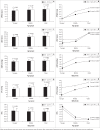Age-related differences in the vascular function and structure of South Africans living with HIV
- PMID: 35284097
- PMCID: PMC8905456
- DOI: 10.4102/sajhivmed.23i1.1335
Age-related differences in the vascular function and structure of South Africans living with HIV
Abstract
Background: As the life expectancy of people living with the HIV increases because of antiretroviral treatment (ART), their risk for vascular co-morbidities and early vascular ageing (EVA) also increases.
Objective: We aimed to investigate whether HIV infection relates to vascular structure and function in black South African adults and whether this relationship is age dependent.
Method: This cross-sectional study carried out in urban and rural areas of North West province, South Africa, included 572 age- and sex-matched people living with HIV (PLWH) and without HIV. Participants from the EndoAfrica study and PURE study were stratified according to tertiles of age. Measures of vascular structure (carotid intima-media thickness) and function (carotid-femoral pulse wave velocity, central systolic blood pressure, central pulse pressure and pulse pressure amplification) were determined.
Results: Blood pressure measures were lower in PLWH compared with their controls (all P ≤ 0.001), especially in the younger and middle-aged groups (all P ≤ 0.031), whilst vascular measures did not differ (all P ≥ 0.611). In multivariate linear regression analyses, vascular measures were not associated with a HIV- positive status in either the total or any of the age groups.
Conclusion: Black South Africans living with HIV have a less adverse blood pressure profile than their counterparts without HIV. The HIV-positive status was not associated with measures of vascular structure or function in any age group. The results suggest that HIV does not contribute to EVA in this population; however, further longitudinal investigation is warranted.
Keywords: antiretroviral treatment; arterial stiffness; carotid intima-media thickness; early vascular ageing; multi-morbidity.
© 2022. The Authors.
Conflict of interest statement
The authors declare that they have no financial or personal relationships that may have inappropriately influenced them in writing this article.
Figures



References
-
- UNAIDS . South Africa 2019: HIV and AIDS estimates [homepage on the Internet]. [cited 2021 Jun 7]. Available from: https://www.unaids.org/en/regionscountries/countries/southafrica
-
- Academy of Medical Sciences (UK), Academy of Science of South (ASSAF) . Improving the prevention and management of multimorbidity in sub-Saharan Africa [homepage on the Internet]. Proceedings report. 2020. [cited 2021 Jun 07]. Available from: https://research.assaf.org.za/handle/20.500.11911/139
-
- Mulè G, Mulè G, Tranchida V, et al. . Aortic stiffness in HIV infection with and without antiretroviral therapy. A meta-analysis of observational studies. Artery Res. 2020;26(1):13–20. 10.2991/artres.k.200314.002 - DOI
Publication types
LinkOut - more resources
Full Text Sources
Research Materials
